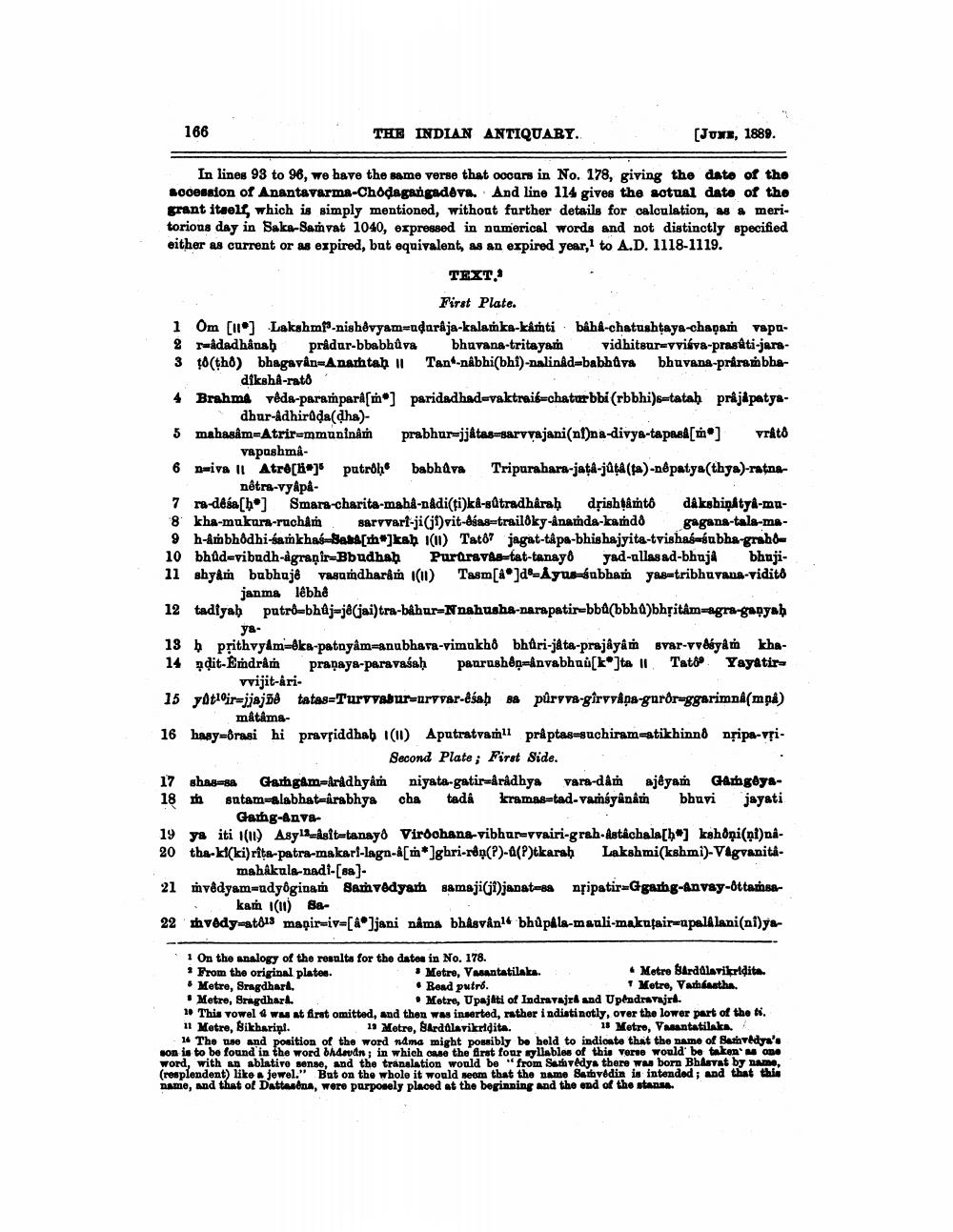________________
166
THE INDIAN ANTIQUARY.
[JUNE, 1889.
In lines 93 to 96, we have the same verse that occurs in No. 178, giving the date of the accession of Anantavarma-Chodagangadeva. And line 114 gives the actual date of the grant itself, which is simply mentioned, without further details for calculation, as a meritorious day in Saka-Samvat 1040, expressed in numerical words and not distinctly specified either as current or as expired, but equivalent, as an expired year,1 to A.D. 1118-1119.
TEXT.
First Plate.
1 Om [*] Lakshm-nishêvyam-udurâja-kalaṁka-kâṁti
baha-chatushṭaya-chaṇam vapu
2
râdadhanah prâdur-bbabhuva bhuvana-tritayam vidhitsur-vviva-prasati-jara3 tô (thô) bhagavan=Anamtaḥ | Tan-nabhi(bhi)-nalinâd-babhava bhuvana-prarambha
diksha-ratô
4 Brahma vêda-parampara[m] paridadhad-vaktrait-chaturbbi (rbbhi)s-tataḥ pråjåpatyadhur-âdhirada(dha)
5 mahasâm-Atrir=mmuninâm
vapushmâ
prabhur-jjtas-sarvvajani(nl)na-divya-tapaal[*]
6 niva II Atrê[*] putroh babhava Tripurahara-jata-juta (ta)-nêpatya (thya)-ratnanêtra-vyâpå
vrâtô
7 ra-desa[b] Smara-charita-maha-nâdi(ţi)kâ-sûtradharaḥ drishtâmtô dakshinâtya-mu8 kha-mukura-rucham sarvvarf-ji(jf)vit-ééas-trailôky-Anamda-kamdo
gagana-tala-ma
9 h-ambhodhi-samkhas-Saba[m]kah (1) Tatô jagat-tâpa-bhishajyita-tvishas=subha-graho10 bhûd-vibudh-agranir-Bbudhah Pururavas-tat-tanayo yad-allas ad-bhuja 11 shyam bubhuje vasumdharam (11) Tasm [*]d-Ayus-subham yas-tribhuvana-viditô janma lêbhê
12 tadiyah putrô-bhuj-jê(jai)tra-bâhur-Nnahusha-narapatir=bbû(bbhú)bhṛitâm-agra-ganyah
ya
13 ↳ prithvy&m=êka-patnyâm-anubhava-vimukhô bhuri-jata-prajâyâm svar-vvsyâm kha14 ndit-Emdrâm pranaya-paravaśaḥ paurushên-ânvabhuù[k]ta Tato Yayatir
vvijit-ari15 yût1ir=jjajõe tatas-Turvvabur-urvvar-êśaḥ sa pûrvva-girvvâṇa-gurðr-ggarimnâ(mpa)
mâtâma
16 hasy-ôrasi hi pravriddhab (11) Aputratvam praptas-suchiram-atikhinn8 nṛipa-vțiSecond Plate; First Side.
bhuji
17 shas-sa Gamgam-Aradhyam niyata-gatir-årådhya vara-dâm ajêyam Ganglys18 m sutam-alabhat-arabhya cha tada kramas-tad-vamsyânâm bhuvi jayati Garg-Anva
19 ya iti (1) Asyla-sit-tanayo Virochana-vibhur-vvairi-grah-Astâchala[*] kshoņi(ni)nâ20 tha-ki(ki) rita-patra-makari-lagn-â[m*]ghri-rên(?)-û(?)tkarah
1 On the analogy of the results for the dates in No. 178. From the original plates.
Metre, Sragdhard.
Metre, Sragdhara.
Lakshmi(kshmi)-Vagvanita
mahakula-nadi-[sa]
21 mvedyam=adyôginam Samvedyam samaji(ji)janat sa nṛipatir=Ggaming-Anvay-ôttamsakam (1) 8a
22 mvédy-atô13 magir-iv-[*]jani nama bhâsvân1 bhûpâla-mauli-makutair-upalâlani(nî)ya
Metre, Vasantatilaka.
Metre Sardalavikridita.
Read putro.
1 Metre, Vathiastha. Metre, Upajati of Indravajra and Upendravajra.
10 This vowel & was at first omitted, and then was inserted, rather indistinctly, over the lower part of the ti. 11 Metre, Bikharini. 13 Metre, Bardalavikridita. 18 Metre, Vasantatilaka.
14 The use and position of the word nama might possibly be held to indicate that the name of Samvedya's son is to be found in the word bhdevan; in which case the first four syllables of this verse would be taken as one word, with an ablative sense, and the translation would be from Samvédya there was born Bhaavat by name, (resplendent) like a jewel." But on the whole it would seem that the name Samvédin is intended; and that this name, and that of Dattasena, were purposely placed at the beginning and the end of the stanse.




